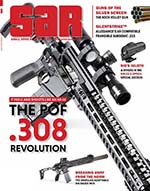Guns of the Silver Screen: V21N7
By Kyle Shea
Harper’s Gun
Here’s forty shillings on the draw
To those who volunteer to come,
To ‘list and fight the foe today
Over the hills and far away.
Those are the lyrics to the ending song of one of the Sharpe series’ episodes. Based on the book series by Bernard Cornwell, the Sharpe series stars fan favorite Sean Bean as Richard Sharpe, a soldier of the 95th Rifles fighting in Spain during the Napoleonic Wars. After saving his commander’s life, he is promoted and, like all real British heroes, is sent on countless missions against the French.
Along the way, he is joined by a group of soldiers called “Chosen Men.” One of them, Patrick Harper, doesn’t get along with Sharpe at first, but over time they become good friends. After a while, Patrick is seen carrying a Nock Volley Gun, a flintlock with seven barrels (Six barrels around one central barrel). It was designed by Henry Nock, a notable gunsmith who made many double barrel shotguns and pistols. His Nock Gun was used by the navy for a while, but use ended due to a multitude of reasons. One of them is because of the recoil. Old muskets already had quite the kick, so having seven barrels on a single musket must have been a nightmare.
Other weapons of the time period were also in the show, including the Brown Bess. Used by the British, the Brown Bess, or the British Land Pattern Musket, is one of the longest serving firearms in history. It has seen action in countless conflicts, including the American Revolution, the War of 1812, the Greek war for Independence, and, of course, the Napoleonic Wars. It was the main weapon of the Infantry, though there were some variations that were used for the Calvary and the Dragoons.
Both the Nock Gun and the Brown Bess were smoothbore weapons, meaning there are no grooves in the barrel. The way these guns were loaded was that you first half-cock the hammer. You then poured some gun powder down it before the musket ball. You then rammed the ball down using the ramrod. You would then pour some powder on the flash pan and then pull the hammer back all the way and you are ready to fire. This was probably another problem for the Nock Gun, because you would have to do this for seven barrels, although there was only one flash pan to fill, firing all seven barrels.
It was during the late 1700s the first rifled muskets were used in warfare. In the American Revolution units like Morgan’s Riflemen helped the Rebel cause, especially at the battles of Saratoga and Cowpens. The militiamen used rifles by hiding behind trees and shooting at enemy units. During the Napoleonic wars the British decided to create their own rifle units, including the 95th Rifles. They used the Baker Rifle and fought throughout the Peninsular War, and later on fought at the Battle of Waterloo. Over time, the rifle would eventually replace the smoothbore musket.
I have only seen the first three parts of the series, but I enjoyed it very much. It feels historically accurate and it has some good action scenes. Sean Bean does a great job as Richard Sharpe, and the other actors are good as well. There are some good side characters and villains. It is worth a watch if you have the time.
This article first appeared in Small Arms Review V21N7 (September 2017) |
| SUBSCRIBER COMMENT AREA |
Comments have not been generated for this article.





